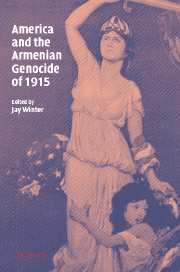Introduction: witness to genocide
Published online by Cambridge University Press: 04 September 2009
Summary
Between the idea
And the reality
Between the motion
And the act
Falls the Shadow.
T. S. Eliot “The Hollow Men” (1925)The Armenian National Institute convened a meeting in Washington in September 2000 out of which this volume emerged. The meeting had two venues: first in the United States Holocaust Memorial Museum, and then in the Library of Congress. The location of this meeting in the heart of the nation's capital, and in two such monumental settings, had a particular importance. For this meeting of scholars from both sides of the Atlantic was testimony to the increasing prominence of the subject of the Armenian genocide in public discourse as well as in contemporary scholarship. It has taken many decades to grow, but by the end of the twentieth century, a consensus has emerged that the Armenian genocide of 1915 is of universal significance. It disclosed much about the century which followed, and, in particular, its history illuminates uncomfortably the obstacles which block international action in situations where genocidal acts appear possible or likely.
This book does not address the question of the justification in general of American or international intervention in “trouble spots” around the world. The disastrous record of US foreign policy in Vietnam, in Chile, and in many other parts of the world where ruling or insurgent movements appeared to threaten American interests or bolster Soviet power precludes any easy argument for the deployment of American power.
- Type
- Chapter
- Information
- America and the Armenian Genocide of 1915 , pp. 1 - 6Publisher: Cambridge University PressPrint publication year: 2004

